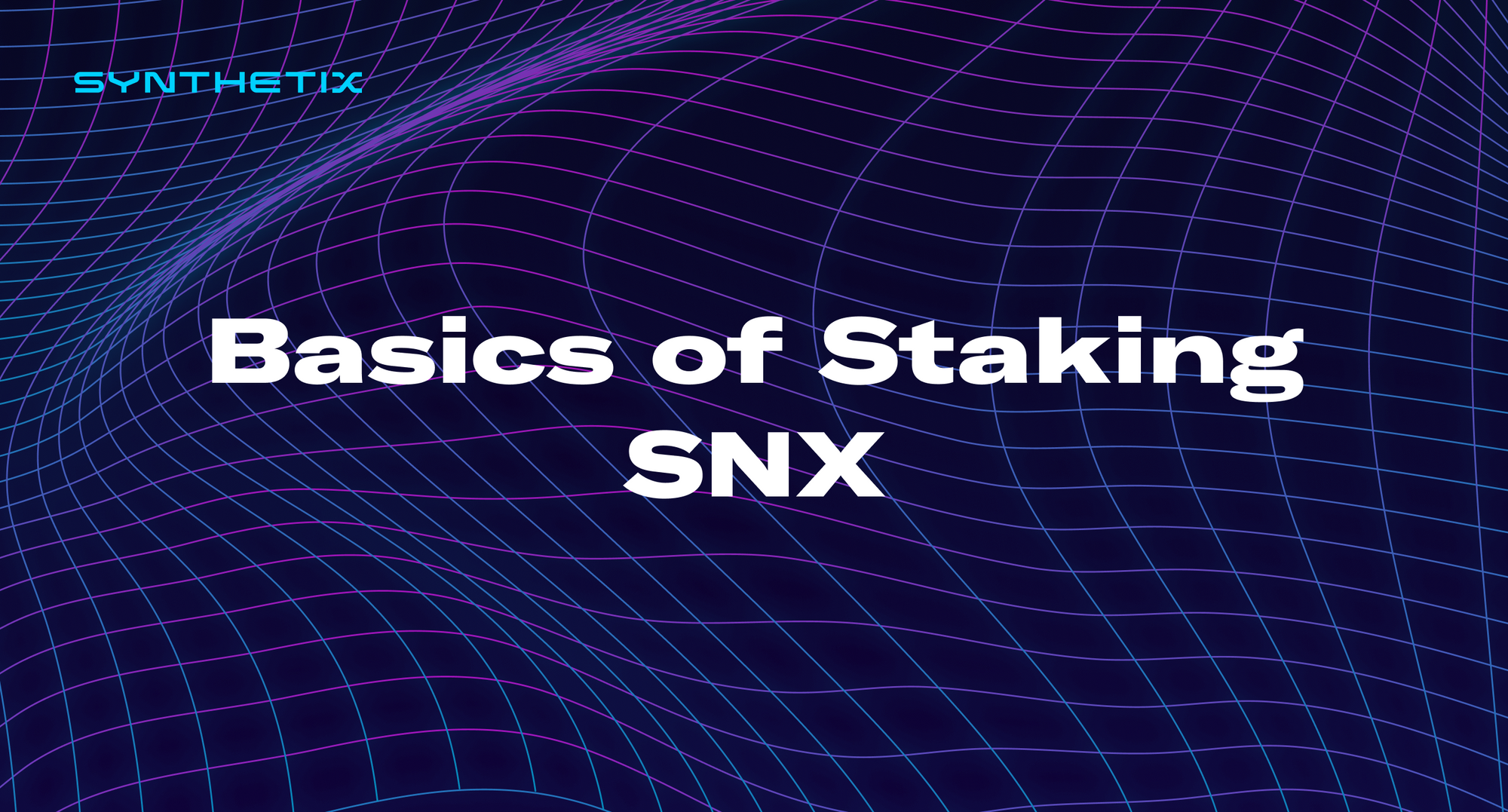Basics of Staking SNX - 2022

For more updated information, monitor Synthetix governance votes and the SIP/SCCP repo.
Synthetix staking is vastly different from other DeFi protocols; it allows anyone to earn rewards by contributing collateral (SNX) to the Synthetix protocol. Staked SNX enables the many benefits for protocols built on Synthetix, such as deep liquidity, low slippage, and highly competitive trading fees.
Staked SNX performs several crucial tasks:
- Creates deep liquidity for Synths trading on Synthetix
- Supports various protocols that rely on Synthetix liquidity (Kwenta, Lyra, Curve, dHEDGE, etc.)
- You receive two kinds of rewards for staking SNX: sUSD fees generated from traders (Kwenta Futures, Lyra options, Kwenta Spot, Curve cross-asset swaps, etc) and SNX inflationary rewards.
- Both of these rewards must be manually claimed in the one transaction each fee period (i.e., once a week), or they will be returned to the pool and redistributed to other stakers.
Basic Steps for Staking on Optimistic Ethereum
- Transfer SNX to a compatible wallet: Metamask, Trezor, Ledger, Coinbase Wallet, Trust Wallet, Rainbow Wallet, and other Wallet Connect supported wallets.
- Go to staking.synthetix.io.
- Bridge your SNX from Layer 1 (Ethereum) to Layer Two (Optimistic Ethereum). The bridge to process this is accessible at https://staking.synthetix.io/l2.
- You'll need to bridge over Ethereum through the optimism gateway to process transactions on Optimism, just like you would on layer one.
- Before going further, ensure that you're connected to the Optimism network by heading over to https://chainlist.org/. Once on chainlist, add Optimistic Ethereum to your metamask.
- Once you've migrated your Synthetix and have bridged over ETH to pay OE transaction fees, you can stake your tokens. You will do this by navigating to the staking menu. Once you're here, you will utilize the 'Mint Max' function and proceed with confirming your transaction.
Basic Steps for Claiming (Weekly)
Information Guide
- You will not receive rewards if you are not staked during the snapshot.
- To receive maximum rewards, ensure you are close to the target C-Ratio. You can do this by minting max on the staking menu.
- Claimed SNX rewards are escrowed for one year. You won’t be able to transfer or sell them during this time, though you will be able to stake them for further staking rewards.
- Maximum rewards are given if you are at or below the target C-Ratio
Mechanics Guide
- Staking rewards are calculated and made available once per week on Wednesdays (3-4PM UTC).
- Navigate to the staking claim menu to claim your rewards for the week https://staking.synthetix.io/earn/claim.
- You won’t be able to claim if your C-Ratio is below the target C-Ratio. Burn your sUSD debt to claim for the week if this is the case.
Debt, Minting & Burning
Quick Summary
- Active debt is your share of the global debt pool. It is not static; it changes with the composition of the debt pool. View the current debt pool composition at https://staking.synthetix.io/debt.
- Issued Debt is the initial value of sUSD that you’re issued when you mint SNX.
- Minting is the process of producing sUSD by locking SNX as collateral (staking)
- Burning is the reverse of minting, and it destroys synths
- Burning increases your C-Ratio, which enables rewards to be claimable
- Burning allows your SNX to be transferable to other wallets
- If you want to have the maximum weekly staking reward, ensure your C-Ratio is at or below the target before the weekly snapshot (Wed morning, EST). Being above the target means you have SNX unstaked and aren’t earning the maximum reward.
Debt Hedging
- As said earlier → Active debt is your share of the global debt pool. It is not static; it changes with the composition of the debt pool. View the current debt pool composition at https://staking.synthetix.io/debt.
- Once you view the composition of the debt pool, you’ll want to take your issued debt (when minting snx) and use it to mirror the composition of the debt pool.
- This is done by buying similar assets to the debt pool on Kwenta. We recommend that you check your debt hedging strategy every week to ensure that you roughly match the composition.
- Ex: If the debt pool is 80% sUSD and 20% sETH, you’d take 20% of your debt and purchase sETH. Now you’re protected from the debt pool increasing
One-Click Debt Hedging - dHEDGE dSNX
Synthetix has partnered with dHEDGE to deploy a one-click debt mirror index for SNX stakers on Optimism. Read the original announcement or the below write-up to hedge with this easy-to-use tool. With this tool, each staker can hedge their exposure to the debt pool in a few clicks.
All a staker must do is navigate to the Synthetix Staking dapp debt section and purchase the dSNX token through the UI, which is integrated into the ‘Manage Tab.’
1 sUSD worth of debt mirror token will hedge one sUSD worth of debt.
Example: If you have 100,000 of sUSD active debt and purchase 100,000 of the dHEDGE debt mirror index token, it will keep your debt in parity with the debt pool without any outside interaction.
To withdraw, a user must navigate to https://toros.finance/derivative/dsnx and click the 'Sell' button.
ETH/BTC Correlated Debt Hedging Strategy - Smaller Stakers
- A new section has been added to the debt composition page, which details the assets you should hedge with based on the current correlation of ETH/BTC
- This is basically the hedge composition after taking into account the 3-month correlation between eth and btc (so eth_short - correlation * btc_long; correlation being around 0.85 and constantly recomputed at an hourly interval on the last 3 months' returns )
- This new strategy may be easier for smaller stakers, as it is as simple as holding $87 of sUSD and $-12 (short) of ETH for every $100 of debt that you own. - Check these numbers regularly, as they change.
- It's important to note that this is not a perfect hedge, it is relying on the correlation of BTC/ETH to be relatively stable.
Matching the Debt Pool Composition - Larger Stakers
- To match the exact composition of the debt place, check the constantly updated Synthetix API and view the user_debt_hedge_in_usd variable for both ETH and BTC
- Now you'll hedge your debt to the exact long and short value of these two variables, and it'll approximately cover the fluctuations of the debt pool
- As of right now, the strategy would look as follows: For every $100 of debt you'd hedge with $40 of ETH and $-59 of BTC.
- You may need more than $100 in capital to hedge your debt, in this case, you'd have to use leverage to hedge.
- While this strategy is more exact to the debt pool composition, it requires more active work. That is why it is recommended for larger stakers.
Debt Pool Composition Notes
- Note - The debt pool composition changes as traders trade; check the debt pool once a week to ensure your strategy still roughly matches the composition of the debt pool.
- This is NOT the only strategy stakers use with their debt, though it does protect stakers from fluctuations in the debt pool and ensures that they’re keeping in line with the changing debt pool.
- Debt hedging is complicated; head to our Discord for individualized questions
Any Questions?
Staking SNX is an exciting way to contribute to a promising DeFi protocol, but it is essential to understand the system's mechanics before getting started.
If you need additional support or have any unanswered questions, join the Synthetix Discord, where you can get helpful information from community members and Synthetix core contributors.
Also, follow Synthetix on Twitter to stay on top of any updates!

